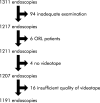Controlled prospective evaluation of the diagnostic yield of a laryngopharyngeal screening examination during upper gastrointestinal endoscopy
- PMID: 15306576
- PMCID: PMC1774177
- DOI: 10.1136/gut.2003.030130
Controlled prospective evaluation of the diagnostic yield of a laryngopharyngeal screening examination during upper gastrointestinal endoscopy
Abstract
Background and aims: Examination of the laryngopharyngeal area is not always performed during routine upper gastrointestinal (UGI) endoscopies although older studies reported pathological findings in 0.9-3.5% of cases. The aim of our study was to prospectively evaluate the positive and negative predictive value of screening the laryngopharyngeal area during routine UGI endoscopy.
Methods: All patients undergoing elective UGI endoscopy between July 2000 and July 2001 were prospectively enrolled into the study. These patients underwent a careful structured examination of the laryngopharyngeal area, which was videotaped for later blinded review. If a pathological finding was suspected, patients were referred to the study otorhinolaryngologist for further evaluation. In all other cases the videotapes were reviewed by the otorhinolaryngologist, who was blinded to the endoscopic findings.
Results: During the study period, 1311 endoscopies were performed in 1209 patients; 1191 were fully evaluated. In 62 endoscopies a pathology in the laryngopharyngeal area was suspected. Forty two were examined by the study otorhinolaryngologist whereas in the remaining 19 only a review of the videotape was possible. In 26 patients pathology was confirmed, corresponding to a positive predictive value of 43% and a negative predictive value of 100%. In one patient (0.08%), an early cancer of the pharyngeal region was detected whereas all other findings were benign lesions.
Conclusions: A screening examination of the laryngopharyngeal area should be part of every UGI endoscopy. A serious pathology such as an early cancer may be detected in approximately 1 in 1000 endoscopies.
Figures


Comment in
-
Can gastro-oesophageal reflux be predicted while advancing the endoscope through the laryngeal area?Gut. 2005 Jun;54(6):890-1. Gut. 2005. PMID: 15888805 Free PMC article. No abstract available.
References
-
- Zavala DC. Diagnostic fiberoptic bronchoscopy: Techniques and results of biopsy in 600 patients. Chest 1975;68:12–19. - PubMed
-
- Klein HC. Routine telescopic laryngoscopy. Am Fam Physician 1975;11:86–9. - PubMed
-
- Lehman G , Compton M, Meadows J, et al. Screening examination of the larynx and pharynx during upper gastrointestinal panendoscopy. Gastrointest Endosc 1982;28:176–8. - PubMed
-
- Kozarek RA. Evaluation of the larynx, hypopharynx, and nasopharynx at the time of diagnostic upper gastrointestinal endoscopy. Gastrointest Endosc 1985;31:271–3. - PubMed
-
- Watanabe S , Matsuda K, Arima K, et al. Detection of subclinical disorders of the hypopharynx and larynx by gastrointestinal endoscopy. Endoscopy 1996;28:295–8. - PubMed
Publication types
MeSH terms
LinkOut - more resources
Full Text Sources
Medical
